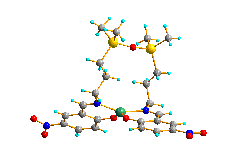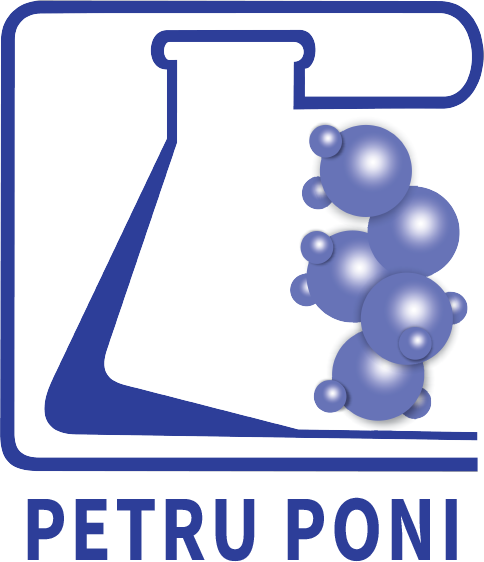Scientific report 2022
STAGE I (2022): Synthesis and characterization of raw materials. Metal complexes. Identification of the adequate characteristics of these fillers for use in siloxane matrices
Stage activities:
Act 1.1 - Synthesis and structural characterization of Salen-type Schiff bases
Act 1.2 - Synthesis of functional polysiloxane prepolymers
Act 1.3 - Synthesis characterization of Schiff bases metal complexes
Act 1.4 - Establishment of an efficient method for composites preparation
All activities proposed to be carried out in Stage I of the DE-Comp project were fully carried out. The main objective of this reporting period was the synthesis and characterization of the raw materials, the synthesis and characterization of the metal complexes obtained, as well as the identification of the appropriate characteristics of these fillers to be used in siloxane matrices.
Act 1.1 – Synthesis and structural characterization of Salen-type Schiff bases
Six salen-type Schiff bases were synthesized according to a previously described method [M. Cazacu et al., Charge and Spin States in Schiff Base Metal Complexes with a Disiloxane Unit Exhibiting a Strong Noninnocent Ligand Character: Synthesis, Structure, Spectroelectrochemistry, and Theoretical Calculations, Inorg. Chem. 2015, 54, 5691−5706; A. Soroceanu et al., Copper(II) Complexes with Schiff Bases Containing a Disiloxane Unit: Synthesis, Structure, Bonding Features and Catalytic Activity for Aerobic Oxidation of Benzyl Alcohol, Eur. J. Inorg. Chem. 2013, 1458–1474.] using the condensation reaction between a salicylic aldehyde or its derivatives and 1,3-bis(3-aminopropyl)tetramethyldisiloxane.
The identification of the structure of the six salen-type Schiff bases was achieved by 1H-NMR analysis and FTIR spectroscopy.
Act 1.2 - Synthesis of functional polysiloxane prepolymers
To make the proposed siloxane prepolymers, in the project's first phase, siloxane polymers with predetermined molecular masses and content of mutually reactive vinyl groups, respectively active hydrogen, attached to the siloxane chain in a lateral or terminal position, were synthesized. The synthesized polymers (PS-V(t)-1 and PS-V(t)-2) were investigated by 1H-NMR and gel permeation chromatography (GPC). Starting from the previously presented polymers, a series of cross-linked elastomeric films were prepared by the hydrosilylation reaction at room temperature between the vinyl and Si-H groups linked to the siloxane chains in the presence of the Karsted catalyst. The doctor blade technique was used to prepare the films.
Act 1.3- Synthesis characterization of Schiff bases metal complexes
Six metal complexes of salen-type Schiff bases were synthesized in solution (methanol) (four coordination compounds of Cu and two coordination compounds of the H2L3 ligand with Ni and Zn) by the "one-pot synthesis" method in which both the formation of the ligand, as well as its complexation, were carried out in the same reactor without the separation and purification of the ligand, using the method previously reported in Act. 1.1.
In all cases, the crystalline phases formed in the concentrated filtrate were isolated by slow evaporation of the solvent at room temperature, the crystals being subjected to structural analysis by single crystal X-ray diffraction. All obtained single crystals were characterized using the following techniques: 1H-NMR, FTIR, TGA, EDX and dielectric spectroscopy. The solubility tests of the investigated metal complexes were carried out in solvents of different polarities, at room temperature, and the results obtained indicated a good solubility of the metal complexes in CH2Cl2, CH3OH and DMF.
Act 1.4 - Establishment of an efficient method for composites preparation
As is known, most polydimethylsiloxanes are in a liquid state at room temperature, and in order to prepare independent films, cross-linking of the polymer chains is necessary. The elastomeric siloxane films were obtained by the reaction of the vinyl groups of α,ω-bis(vinyl)polydimethylsiloxane) with the Si-H groups of α,ω-bis(trimethylsiloxy)poly(dimethylsiloxane-co-methylhydrosiloxane), carried out at room temperature, in the presence of the Karsted catalyst.
The results obtained through the implementation of the DE-Comp project during the first stage of development were disseminated at international scientific events, in the form of oral and poster communications, as well as in the form of a published article: A. Soroceanu*, A. Bargan, Advanced and Biomedical Applications of Schiff-Base Ligands and Their Metal Complexes: A Review, Crystals 2022, 12, 1436. https://doi.org/10.3390/cryst12101436 .
The web page of the project was permanently updated during the development of the first stage of the project, all the results obtained being visible at the address https://www.icmpp.ro/de-comp/.
|



